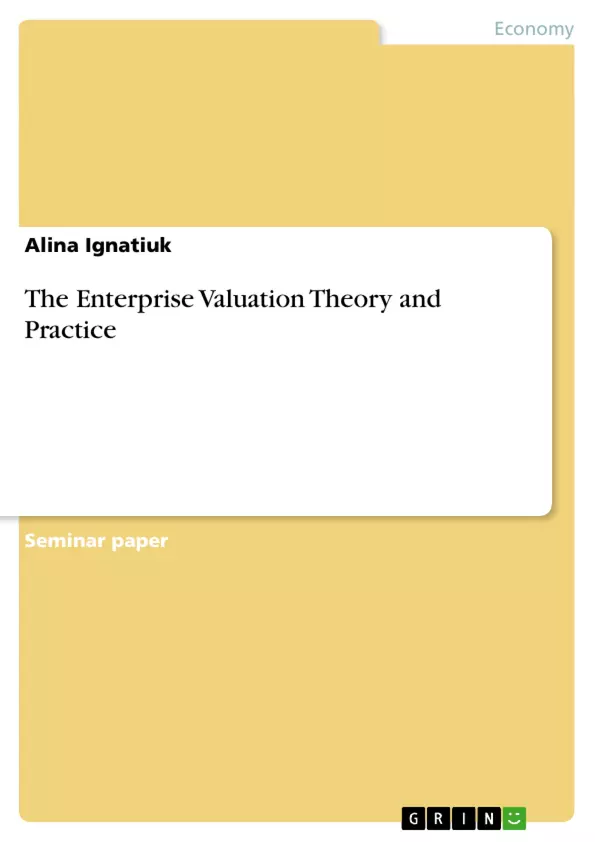In a market-driven economy investors are looking for the most profitable placement of their capital. This leads to a redistribution of the recourses on economy-wide scale from industries and companies which use investor’s capital inefficiently and destroy wealth to industries and companies which use investor’s capital efficiently and create wealth. For corporate managers, wealth creation is fundamental to the economic survival of the firm. As suggested by Rapport (2006, pp.67-68) managers that fail (or refuse) to see the importance of this imperative in an open economy do so at the peril of the organization and their own careers. There are several analytical tools which can help to make wise decisions in this field. They range from traditional Dividend Discount model and Free Cash Flow (FCF) model to not so long ago created Economic Value Added (EVA) model of enterprise valuation.
At the same time in line with theoretical models for valuing companies there is a market value for companies derived from market supply and demand for their stocks. In general, if we again refer to “one value principle” described in Grant (2003, p.106), both theoretical and market approaches have to lead to the same results. But in reality there is always some discrepancy in those two values which is a result of the influence of the number of factors. Identification and analysis of those factors is of key importance for investors to discover the most profitable investments and for the economy to ensure the most efficient use of capital.
The discrepancy between theoretical and market value of the company, however, should not last forever. If it happens then capital market will be sending wrong signals to the investors about on the one hand industries with high potential which use capital productively and create economic profit and on the other hand industries with low potential who waste capital and achieve economic loss. This would lead to a situation when productive industries will face a deficit of capital and unproductive industries will face a surplus of capital. Such inefficient distribution of capital finally would be a threat for the development of a real sector of the economy.
Inhaltsverzeichnis (Table of Contents)
- Introduction
- Theory of enterprise valuation model
- FCF valuation model
- EVA valuation model
- Comparison of FCF and EVA models
- Problems in Enterprise valuation
- Ex ante MVA and Ex post MVA
- Calculation of WACC
- Conclusion
Zielsetzung und Themenschwerpunkte (Objectives and Key Themes)
This paper delves into the theory and practice of enterprise valuation, examining various models and their applications. It aims to provide a comprehensive understanding of how investors and managers can utilize valuation tools to make informed decisions about resource allocation and wealth creation.
- The importance of enterprise valuation for investors and managers in a market-driven economy
- Comparison and analysis of traditional FCF and EVA models for enterprise valuation
- Challenges and complexities associated with enterprise valuation, including the calculation of WACC and the distinction between ex ante and ex post MVA
- The relationship between theoretical valuation models and market values, and the significance of reconciling these values
- The impact of efficient and inefficient capital allocation on the growth and development of the real sector of the economy
Zusammenfassung der Kapitel (Chapter Summaries)
The first chapter introduces the concept of enterprise valuation and its significance in a market-driven economy. It highlights the importance of wealth creation for corporate managers and the role of valuation tools in making informed decisions. The chapter also introduces the traditional Dividend Discount model and the Free Cash Flow (FCF) and Economic Value Added (EVA) models as analytical tools for enterprise valuation.
Chapter 2 provides a detailed theoretical analysis of the FCF and EVA valuation models. The FCF model is explained based on the principle that the market value of a company can be represented as a discounted stream of future cash flows. The chapter then introduces the concept of horizon and residual periods, along with simplifying assumptions for calculating the present value of future cash flows. The chapter concludes with a discussion of the EVA valuation model and its advantages over the traditional FCF model.
Schlüsselwörter (Keywords)
Enterprise valuation, FCF model, EVA model, discounted cash flow, WACC, MVA, wealth creation, investor decision-making, market value, theoretical value, capital allocation, economic profit.
- Arbeit zitieren
- Alina Ignatiuk (Autor:in), 2008, The Enterprise Valuation Theory and Practice, München, GRIN Verlag, https://www.hausarbeiten.de/document/130200


